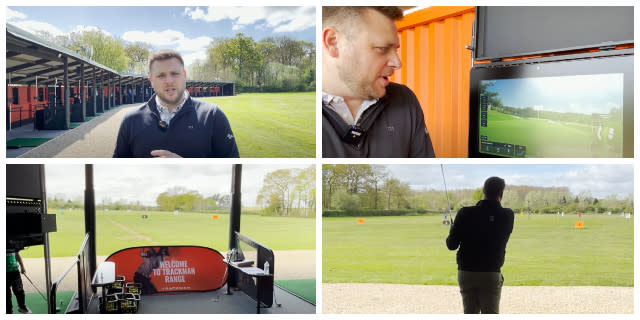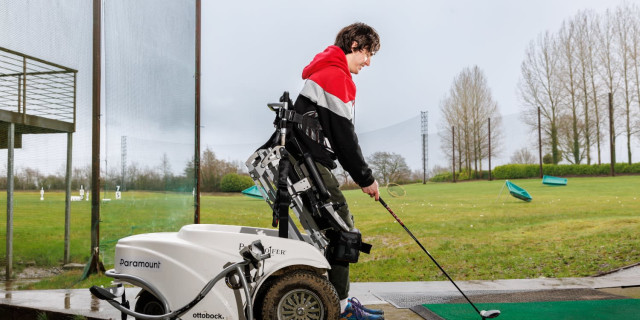
Understanding Golf's New and Modernised Rule Book
YOU are probably aware that a raft of new rules are to be introduced on January 1 next year. They are the most wide-ranging changes the game has seen for years and they are designed to make it easier to play and more attractive for newcomers. The good news is that the game’s governing bodies, the R&A and the USGA, have actually been consulting club golfers. As a result, four of the proposed changes have now been redrafted.
However, there are those who are bound to feel that some chances have been missed. Speak to any club golfer and ask them for the one rule they would want to change and the chances are pretty high that they would tell you that they would want a free drop when they walk up to a drive in the middle of the fairway and find their ball sitting in the middle of an old divot. And yes, you are right, the powers-that-be have failed to address this one.
But lots of good things are happening. We thought it might be helpful to run through a few of the alterations so we have put together a few examples looking at how the rules work just now and how they will change. So let’s start with the four rule changes that saw them go back to the drawing board.

1. Stroke-and-distance penalties
What they proposed: There was no proposed alternative to the stroke-and-distance penalty.
What will happen: A new local rule will permit committees to do away with the stroke-and-distance penalty. Golfers will now be allowed to drop the ball in the vicinity of where it was lost and/or went out of bounds, under a two-stroke penalty. That means that if you hit your drive out of bounds, you would be hitting your fourth shot from the spot where you drop. This will not apply to professional tournaments. It is specifically designed to speed up play in recreational and club-level play.
2. Double-hits
What they proposed: Retaining the existing one-stroke penalty
What will happen: Eliminating the one-stroke penalty for a double-hit. Golfers will simply count the extra stroke they took while swinging at the ball.
3. How to take a proper drop
What they proposed: Allowing golfers to drop from as low as two inches off the ground. There was a huge amount of debate and controversy over this proposal, with many people believing that this actually amounted to allowing golfers to take a preferred lie.
What will happen: Golfers will now drop from knee height.
4. How to measure when taking relief
What they proposed: Within 20 inches or 80 inches, depending on the situation (taking relief from a cart path, say, or a lateral hazard).
What will happen: Within one or two club lengths, depending on the situation.
And this is how the rest of it shapes up…
Ball at Rest
Player accidentally moves his or her ball during search
Current rule: one-stroke penalty.
New rule: No penalty.
Player accidentally moves his or her ball or ball-marker on the putting green
Current rule: one-stroke penalty
New rule: No penalty.
Standard for deciding whether the player caused his or her ball to move
Current rule: Weight of the evidence/more likely than not.
New rule: The player will be found to be the cause only when it is known or virtually certain to be the case.
How to replace a ball lying off the putting green when it moves and its exact original spot isn’t known
Current rule: Drop the ball as near as possible to the estimated spot.
New rule: Replace the ball on its estimated spot; if that spot was on, under or against attached natural objects, replace the ball on that spot on, under or against those objects.
Ball in Motion
Player’s ball in motion accidentally hits the player, his or her caddie, the person attending the flagstick or the attended or removed flagstick
Current rule: one-stroke penalty (two-stroke penalty when the accidental deflection relates to the flagstick or the attendant).
New rule: No penalty.
Taking Relief
Where a ball must be dropped
Current rule: Sometimes the drop is in a specified area, sometimes it is on or as near as possible to a spot or a line.
New rule: Drop in a defined relief area.
Where a dropped ball must come to rest
Current rule: The ball must be re-dropped if it rolls to any of the nine specified areas (Rule 20-2c), such as rolling more than two club-lengths from where the dropped ball struck the ground.
New rule: The ball must come to rest in the relief area where it was dropped, or else the ball must be re-dropped.
Measuring the size of the relief area where a ball must be dropped and played
Current rule: Measured by using one or two club-lengths (with any length club the player chooses).
New rule: The relief area is measured by a fixed distance of 20 inches or 80 inches from the reference point or the reference line; this can readily be measured by using markings on the shaft of a club
Time allowed for a ball search
Current rule: A ball is lost if not found in five minutes.
New rule: A ball is lost if it is not found in three minutes. A move designed to speed up play but there are obvious concerns about how it will be enforced.
Substituting ball when taking relief
Current rule: The player must use the original ball when taking free relief (with exceptions); a substituted ball is allowed only when taking penalty relief.
New rule: A player may substitute a ball when taking relief.
Taking relief for a ball embedded in its own pitchmark
Current rule: Relief is allowed only in areas cut to fairway height or less, unless a Local Rule has been adopted allowing relief anywhere (except in sand) through the green.
New rule: A player may take relief without penalty for an embedded ball anywhere (except in sand) in the "general area" (new term for "through the green"), unless a Local Rule has been adopted restricting relief only to areas cut to fairway height or less.
Areas of the Course
Replacing a ball on the putting green when it moves from its spot after it had been lifted and replaced
Current rule: The ball is replaced only if a player or outside agency caused it to move; otherwise, the ball is played from its new location.
New rule: The ball must always be replaced on its original spot, even if it was blown by the wind or moved for no clear reason.
Repairing damage on the putting green
Current rule: A player may only repair ball-marks or old hole plugs on the putting green.
New rule: A player may repair almost any damage (including spike marks and animal damage but not including natural imperfections) on the putting green. At last, a victory for common sense as this rule will also apply to the professional game
Player touches the line of putt or touches the putting green in pointing out a target
Current rule: Loss of hole/two-stroke penalty (with exceptions).
New rule: No penalty, as long as doing so does not improve the conditions for the player’s stroke.
Putting with an unattended flagstick left in the hole
Current rule: Loss of hole/two-stroke penalty if the ball is played from the putting green and hits the unattended flagstick in hole.
New rule: No penalty if a ball played from the putting green (or anywhere else) hits the unattended flagstick in hole.
Areas the Committee may mark as a penalty area (where relief with one-stroke penalty is allowed)
Current rule: Relief is allowed only from areas marked as "water hazards."
New rule: Red- and yellow-marked "penalty areas" may now cover areas of desert, jungle, lava rock, etc., in addition to water.
Player moves loose impediments, touches the ground with hand or club or grounds the club in a penalty area when the ball is in the penalty area
Current rule: Loss of hole/two-stroke penalty (with exceptions).
New rule: No penalty.
Expanded use of red-marked penalty areas
Current rule: All water hazards should be marked yellow, except where their location on the course makes it impossible or unreasonable to drop behind the hazard; only when this is the case may these water hazards be marked red as lateral water hazards.
New rule: Committees now have discretion to mark all penalty areas as red so that lateral relief is always allowed, but may still mark penalty areas as yellow where they consider it appropriate.
Elimination of the opposite side relief option for red penalty areas
Current rule: A player is always allowed to take relief from the opposite side of a red-marked lateral water hazard.
New rule: A player is no longer allowed to take relief from a red penalty area on the opposite side from where the ball last entered that penalty area, unless the Committee adopts a Local Rule allowing it.
Player moves or touches a loose impediment in a bunker when the ball is in the bunker
Current rule: Loss of hole/two-stroke penalty (with exceptions).
New rule: No penalty.
Player touches sand in a bunker with his or her hand or a club when the ball is in the bunker
Current rule: Any touching of sand with hand or club results in loss of hole/two-stroke penalty (with exceptions).
New rule: No penalty except when a player touches the sand with his or her hand or club to test the conditions of the bunker or with the club in the area right behind or in front of the ball, in making a practice swing or in making the backswing for the stroke. This one is somewhat confusing as there appear to be no occasions when a player could possibly touch the sand with his hand by accident
Unplayable ball relief options
Current rule: No relief outside the bunker, other than in playing from where the player’s last stroke was made).
New rule: A player may take relief outside the bunker back on a line from the hole through where ball was at rest for two penalty strokes.
Equipment
Use of clubs damaged during round
Current rule: A player may use the damaged club only if it was damaged in the "normal course of play."
New rule: A player may keep using any damaged club, even if it was damaged it in anger.
Adding clubs to replace a club damaged during round
Current rule: A player may replace a damaged club if it is "unfit for play" and was damaged in the "normal course of play."
New rule: A player may not replace a damaged club, unless the player was not responsible for the damage.
Use of distance-measuring devices (DMDs)
Current rule: DMD use is prohibited, unless a Local Rule has been adopted allowing their use.
New rule: The use of DMDs is allowed, unless a Local Rule has been adopted prohibiting their use. There are still those who will hold their hands up in horror at this but it should speed up play.
Playing a Ball
Caddie standing behind a player to help with that player’s alignment
Current rule: A caddie is allowed to stand on a line behind a player while the player is taking a stance and preparing to play, but must not stand there while the player makes the stroke.
New rule: A caddie is not allowed to stand on a line behind a player while the player is taking his or her stance and until stroke is made. At last! This means we will no longer see something that has become something of an epidemic, especially on the LPGA Tour.
Caddie lifts and replaces the player’s ball on the putting green
Current rule: one-stroke penalty if done without the player’s specific authorisation.
New rule: A caddie may lift and replace the player’s ball on the putting green without the player’s specific authorisation to do so. Again, it is difficult to see any circumstances when a player would actually want his caddie to lift and replace his golf ball.
When to Play During a Round
Recommendations on how to play promptly
Current rule: No recommendations are given.
New rule: Recommends that players make each stroke in no more than 40 seconds, and usually in less time. The key here will be whether or not the PGA and European Tours have the courage to impose penalties when players fail to achieve this – in other words, on just about every shot played on both tours.
Playing out of turn in stroke play
Current rule: No penalty, but the current rule is written in a way that may imply that playing out of turn is wrong or is not allowed.
New rule: No penalty (as today), and "ready golf" is encouraged when it can be done in a safe and responsible way. It is great to see the ruling bodies finally encouraging ready golf – another move designed to speed up play.
Other changes to help pace of play
Other new rules: Simplified dropping rules, allowing more areas to be marked as penalty areas, expanded use of red penalty areas and allowing a player to putt with the flagstick in the hole.
New alternative form of strokeplay
Current rule: In standard individual strokeplay, players must hole out at every hole; the only recognised alternative forms of strokeplay where holing out is not required are Stableford, Par and Bogey.
New rule: A new "Maximum Score" form of stroke play is to be recognised, where a player’s score for a hole is capped at a maximum score (such as double- or triple-bogey) that is set by the committee.
Player Behaviour
Playing in the spirit of the game
Current rule: The rules set out no standards of conduct, except indirectly in giving committees discretion to disqualify players for breaches of etiquette.
New rule: Explains and reinforces the high standards of conduct expected from players and gives a committee discretion to disqualify players for serious misconduct.
Code of player conduct
Current rule: Committees may disqualify players for a serious breach of etiquette, but are not allowed to impose lesser penalties such as a one-stroke penalty or a loss of hole/two-stroke penalty.
New rule: Committees are given authority to adopt their own code of player conduct and to set penalties for the breach of the standards in that code.
Eliminating announcement requirements before lifting a ball under certain Rules
Current rule: Before lifting in these cases, the player must announce to another player or the marker that he or she is doing so and allow that person to observe the process.
New rule: When a player has good reason to mark and lift a ball to identify it, check for damage or see if it lies in a condition where relief is allowed (such as to see whether it is embedded), the player will no longer be required first to announce to another player or his or her marker the intent to do so or to give that person an opportunity to observe the process. There are bound to be concerns that this opens the door for abuse by unscrupulous players, who will use it as opportunity to improve the lie of their golf ball
Player’s reasonable judgment in estimating and measuring under a rule
Current rule: A player’s judgment is given no particular weight or deference; the committee decides any issue about the accuracy of the estimation or measurement based on a review of all facts.
New rule: When estimating or measuring a spot, point, line, area or distance under a Rule, a player’s reasonable judgment will not be second-guessed based on later evidence (such as video review) if the player did all that could be reasonably expected under the circumstances to make an accurate estimation or measurement.
Phew! Well that is about it. Let us know what you think.
What do you think? post your thoughts and feedback on the Golfshake Forum: https://forum.golfshake.com/
Tags: rules









